中考英语语法大全——主谓一致(共20张PPT)
文档属性
| 名称 | 中考英语语法大全——主谓一致(共20张PPT) |  | |
| 格式 | ppt | ||
| 文件大小 | 2.3MB | ||
| 资源类型 | 教案 | ||
| 版本资源 | 通用版 | ||
| 科目 | 英语 | ||
| 更新时间 | 2022-04-10 18:49:46 | ||
图片预览

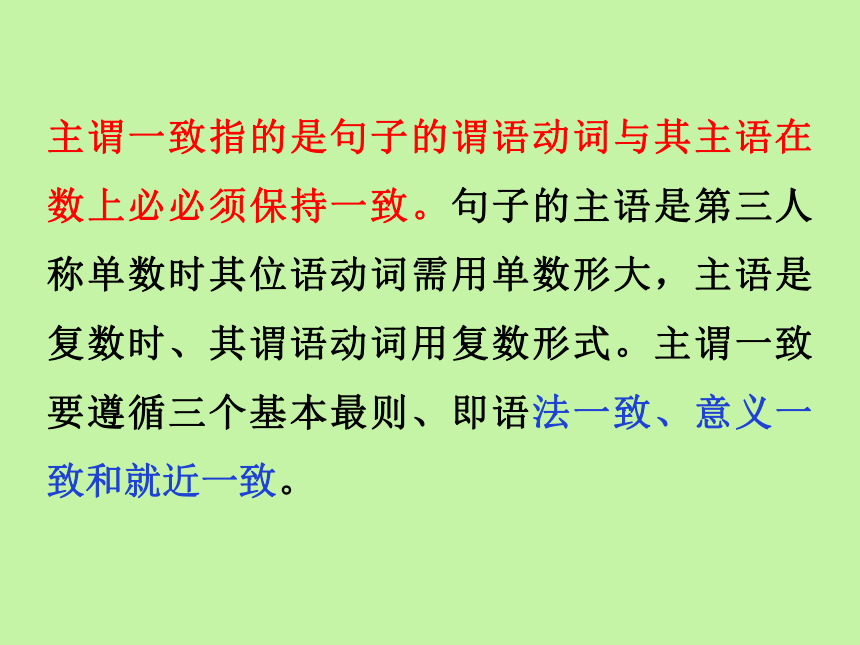

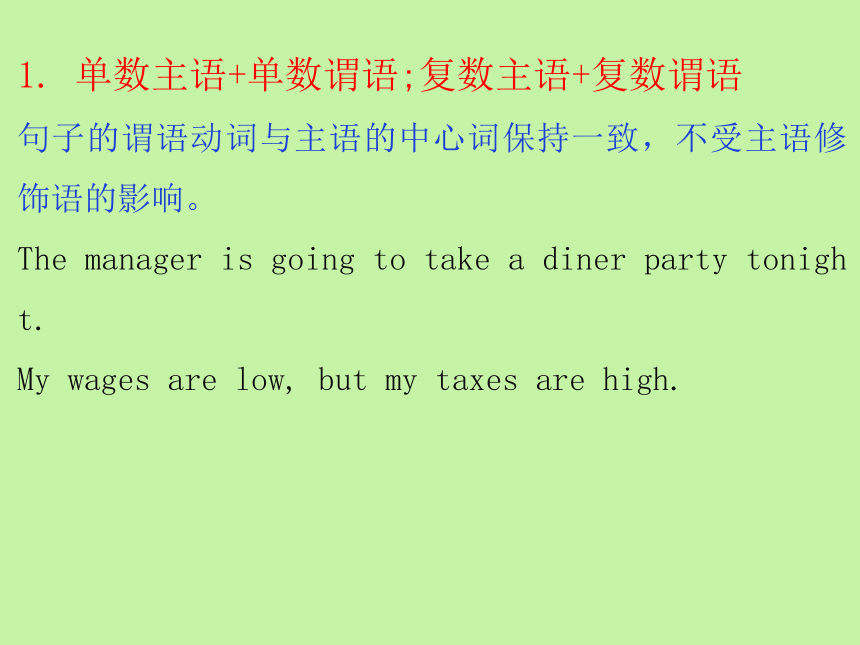
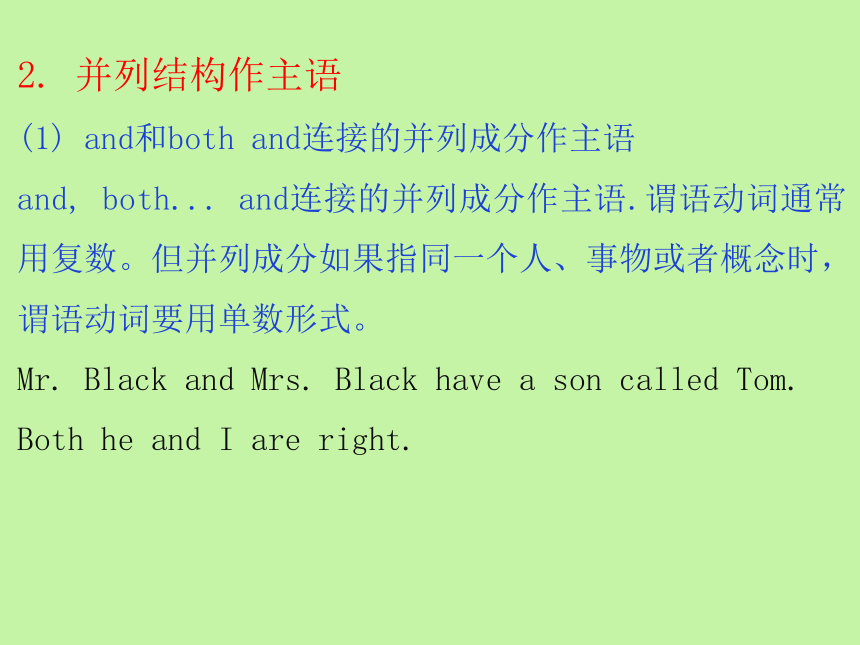
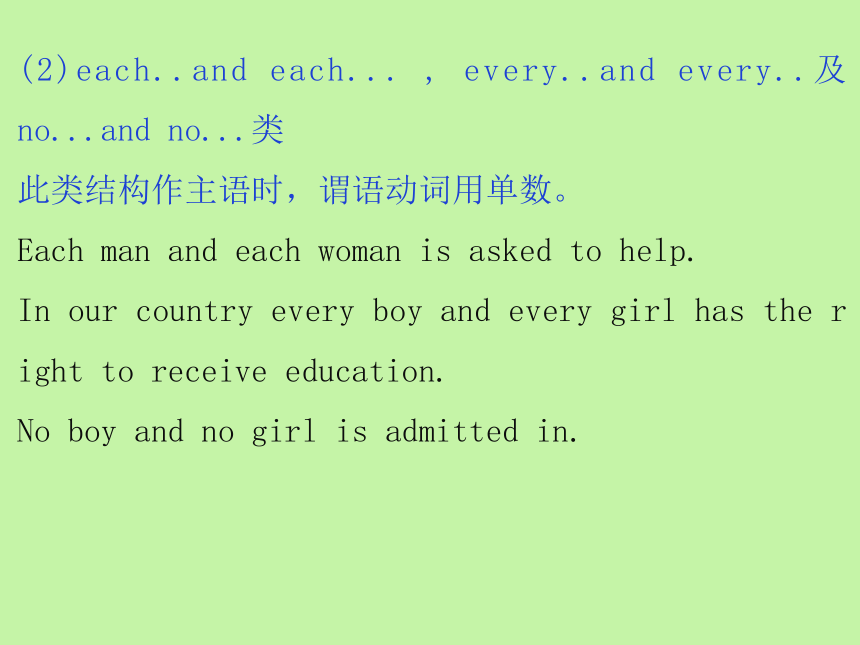
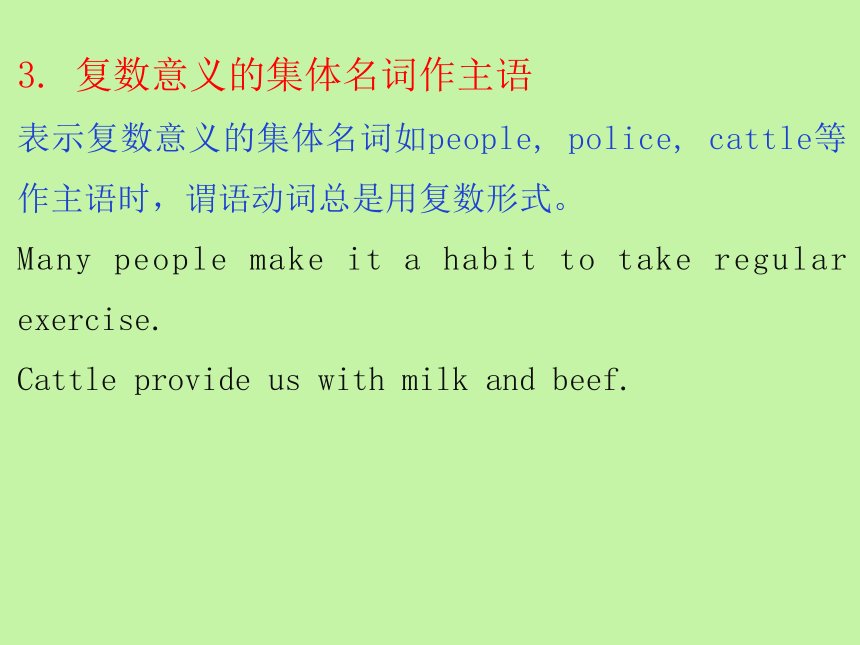
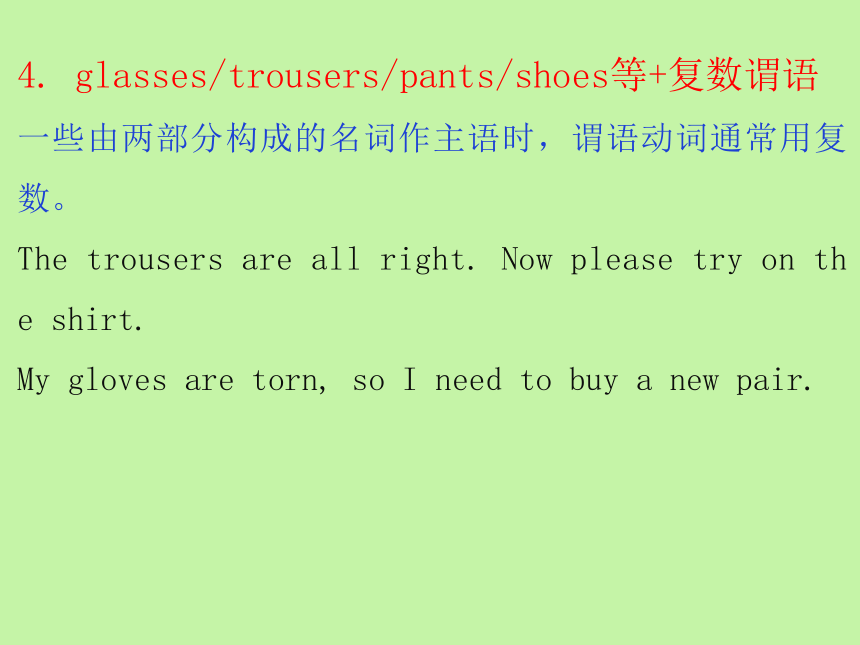

文档简介
(共20张PPT)
主谓一致指的是句子的谓语动词与其主语在数上必必须保持一致。句子的主语是第三人称单数时其位语动词需用单数形大,主语是复数时、其谓语动词用复数形式。主谓一致要遵循三个基本最则、即语法一致、意义一致和就近一致。
语法一致
1. 单数主语+单数谓语;复数主语+复数谓语
句子的谓语动词与主语的中心词保持一致,不受主语修饰语的影响。
The manager is going to take a diner party tonight.
My wages are low, but my taxes are high.
2. 并列结构作主语
(1) and和both and连接的并列成分作主语
and, both... and连接的并列成分作主语.谓语动词通常用复数。但并列成分如果指同一个人、事物或者概念时,谓语动词要用单数形式。
Mr. Black and Mrs. Black have a son called Tom.
Both he and I are right.
(2)each..and each... , every..and every..及no...and no...类
此类结构作主语时,谓语动词用单数。
Each man and each woman is asked to help.
In our country every boy and every girl has the right to receive education.
No boy and no girl is admitted in.
3. 复数意义的集体名词作主语
表示复数意义的集体名词如people, police, cattle等作主语时,谓语动词总是用复数形式。
Many people make it a habit to take regular exercise.
Cattle provide us with milk and beef.
4. glasses/trousers/pants/shoes等+复数谓语
一些由两部分构成的名词作主语时,谓语动词通常用复数。
The trousers are all right. Now please try on the shirt.
My gloves are torn, so I need to buy a new pair.
5. A+with/along with/as well as等短语+B
主语后带有with, together with, as well as, no less than, along with等短语时,谓语动词不受这些短语的影响,仍然与主语保持致。
The teacher together with some students is visiting the factory.
He as well as I wants to go boating.
意义一致
1. 表示数量概念的词作主语
(1)表示时间距离价值重量等的名词作主语
Ten yuan is enough. 10元足够了。
One hundred kilometers is a long distance. 100千米是一段很长的距离。
Two hours is too short for the visit. 两个小时的参观太短了。
(2) a number of/the number of +复数可数名词+复数谓语/单数谓语
“a number of ”复数可数名词表示“许多......”,作主语时,谓语动中用复数;the number of+复数可数名词表示“......的数目”。作主语时谓语动词用单数。
A number of cars are parked in front of my house. 许多小汽车停在我家门前。
The number of the students has increased recently. 学生的数目最近有所上升。
(3)数量词+of+单数可数名词/不可数名词/复数可数名词+单数谓语/复数谓语
此结构中常用的数量词有most rest, pat, half, several, many, few, 分数, 百分数等。谓语动词与of后的名词保持数的一致。
Most of the boys are fond of watching football games.
--- What does the fresh juice contain --- Four-fifths of the juice is orange. It's very pure.
2. 不定式动名词/从句作主语
不定式动名词或从句作主语谓语动词一般用单数形式,但and连接的两个或多个不定式动名词或从向作主语表示不同概念时,谓语动词用复数形式。
Reading often means learning.读书常意味着学习。
To say something is usually easier than to do something. 说往往要比做容易。
3. “the+形容词/分词” 作主语
形容词/分词”表示一类人时,谓语动词用复数形式;表示一类事物或抽象概念时,谓语动词用单数形式。
The sick have been cured and the lost have been found.
The new is sure to replace the old.
4. 集体名词作主语
class/family/group等集体名词+单数谓语(侧重整体)/ +复数谓语(侧重整体中的个体)
My family is a happy one.我家是一个幸福的家庭。
My family are watching TV.我们全家人正在看电视。
就近一致
1. there be句型的就近一致
there be句型中be后如果有两个或两个以上的名词,由靠近be的那个名词来决定单复数。如:
There is a teacher and seventy students in the classroom.教室里有一个老师和七十个学生。
There are seventy students and a teacher in the classroom.教室里有七十个学生和一个老师。
2.部分连词句型的主谓一致
由连词either ... or... (或者......,或者......,不是......就是......), neither... nor... (既不......也不......;两者都不),not ... but ... (不是......就是......), not only... but also ... (不但......而且......)等连接的名词或代词作主语时,谓语动词的形式须跟与之最接近的名词或代词一致。如:
Either you or I am wrong.
Neither he nor you are to blame.
Not I but LiuTao is going to take part in the game.
Not only you but also Mr. Zhang teaches in this school.
主谓一致指的是句子的谓语动词与其主语在数上必必须保持一致。句子的主语是第三人称单数时其位语动词需用单数形大,主语是复数时、其谓语动词用复数形式。主谓一致要遵循三个基本最则、即语法一致、意义一致和就近一致。
语法一致
1. 单数主语+单数谓语;复数主语+复数谓语
句子的谓语动词与主语的中心词保持一致,不受主语修饰语的影响。
The manager is going to take a diner party tonight.
My wages are low, but my taxes are high.
2. 并列结构作主语
(1) and和both and连接的并列成分作主语
and, both... and连接的并列成分作主语.谓语动词通常用复数。但并列成分如果指同一个人、事物或者概念时,谓语动词要用单数形式。
Mr. Black and Mrs. Black have a son called Tom.
Both he and I are right.
(2)each..and each... , every..and every..及no...and no...类
此类结构作主语时,谓语动词用单数。
Each man and each woman is asked to help.
In our country every boy and every girl has the right to receive education.
No boy and no girl is admitted in.
3. 复数意义的集体名词作主语
表示复数意义的集体名词如people, police, cattle等作主语时,谓语动词总是用复数形式。
Many people make it a habit to take regular exercise.
Cattle provide us with milk and beef.
4. glasses/trousers/pants/shoes等+复数谓语
一些由两部分构成的名词作主语时,谓语动词通常用复数。
The trousers are all right. Now please try on the shirt.
My gloves are torn, so I need to buy a new pair.
5. A+with/along with/as well as等短语+B
主语后带有with, together with, as well as, no less than, along with等短语时,谓语动词不受这些短语的影响,仍然与主语保持致。
The teacher together with some students is visiting the factory.
He as well as I wants to go boating.
意义一致
1. 表示数量概念的词作主语
(1)表示时间距离价值重量等的名词作主语
Ten yuan is enough. 10元足够了。
One hundred kilometers is a long distance. 100千米是一段很长的距离。
Two hours is too short for the visit. 两个小时的参观太短了。
(2) a number of/the number of +复数可数名词+复数谓语/单数谓语
“a number of ”复数可数名词表示“许多......”,作主语时,谓语动中用复数;the number of+复数可数名词表示“......的数目”。作主语时谓语动词用单数。
A number of cars are parked in front of my house. 许多小汽车停在我家门前。
The number of the students has increased recently. 学生的数目最近有所上升。
(3)数量词+of+单数可数名词/不可数名词/复数可数名词+单数谓语/复数谓语
此结构中常用的数量词有most rest, pat, half, several, many, few, 分数, 百分数等。谓语动词与of后的名词保持数的一致。
Most of the boys are fond of watching football games.
--- What does the fresh juice contain --- Four-fifths of the juice is orange. It's very pure.
2. 不定式动名词/从句作主语
不定式动名词或从句作主语谓语动词一般用单数形式,但and连接的两个或多个不定式动名词或从向作主语表示不同概念时,谓语动词用复数形式。
Reading often means learning.读书常意味着学习。
To say something is usually easier than to do something. 说往往要比做容易。
3. “the+形容词/分词” 作主语
形容词/分词”表示一类人时,谓语动词用复数形式;表示一类事物或抽象概念时,谓语动词用单数形式。
The sick have been cured and the lost have been found.
The new is sure to replace the old.
4. 集体名词作主语
class/family/group等集体名词+单数谓语(侧重整体)/ +复数谓语(侧重整体中的个体)
My family is a happy one.我家是一个幸福的家庭。
My family are watching TV.我们全家人正在看电视。
就近一致
1. there be句型的就近一致
there be句型中be后如果有两个或两个以上的名词,由靠近be的那个名词来决定单复数。如:
There is a teacher and seventy students in the classroom.教室里有一个老师和七十个学生。
There are seventy students and a teacher in the classroom.教室里有七十个学生和一个老师。
2.部分连词句型的主谓一致
由连词either ... or... (或者......,或者......,不是......就是......), neither... nor... (既不......也不......;两者都不),not ... but ... (不是......就是......), not only... but also ... (不但......而且......)等连接的名词或代词作主语时,谓语动词的形式须跟与之最接近的名词或代词一致。如:
Either you or I am wrong.
Neither he nor you are to blame.
Not I but LiuTao is going to take part in the game.
Not only you but also Mr. Zhang teaches in this school.
同课章节目录
- 词法
- 名词
- 动词和动词短语
- 动词语态
- 动词时态
- 助动词和情态动词
- 非谓语动词
- 冠词
- 代词
- 数词和量词
- 形容词副词及其比较等级
- 介词和介词短语
- 连词和感叹词
- 构词法
- 相似、相近词比较
- 句法
- 陈述句
- 一般疑问句和否定疑问句
- 特殊疑问句及选择疑问句
- 反意疑问句
- 存在句(There be句型)
- 宾语从句
- 定语从句
- 状语从句
- 主谓一致问题
- 简单句
- 并列句
- 复合句
- 主谓一致
- 主、表语从句
- 名词性从句
- 直接引语和间接引语
- 虚拟语气
- 感叹句
- 强调句
- 倒装句
- 祈使句
- 句子的成分
- 句子的分类
- 题型专区
- 单项选择部分
- 易错题
- 完形填空
- 阅读理解
- 词汇练习
- 听说训练
- 句型转换
- 补全对话
- 短文改错
- 翻译
- 书面表达
- 任务型阅读
- 语法填空
- 其他资料
